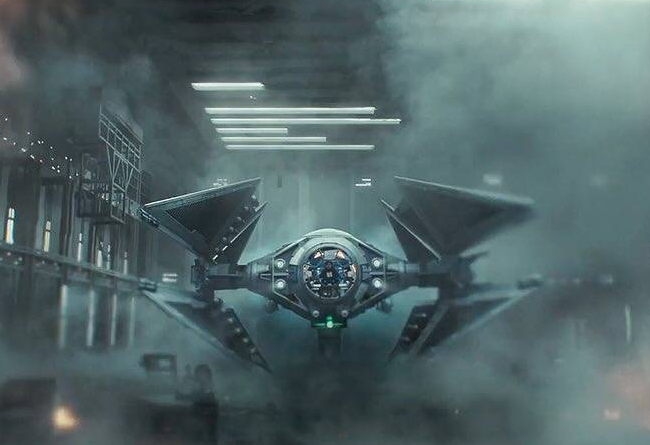Craft: Sienar Fleet Systems’ TIE/ad Avenger
Type: Space superiority fighter
Scale: Starfighter
Length: 13.41 meters
Skill: Starship piloting: TIE/ad Avenger
Crew: 1
Crew Skill: Astrogation 5D, Starfighter piloting 5D+2, starship gunnery 4D+2, starship shields 4D+2
Cargo Capacity: 70 kilograms
Passengers: 2
Consumables: 2 days
Cost: 700,000 Credits
Hyperdrive Multiplier: x1
Nav Computer: Yes (SFS N-s6 Navcon computer system)
Maneuverability: 5D
Space: 12
Atmosphere: 450; 1,300 kmh
Hull: 3D+2 (Titanium hull with Quadanium steel solar panels)
Shields: 2D+1 (Novaldex deflector shield generators)
Sensors:
Passive: 25/1D+1
Scan: 40/2D
Search: 60/3D+2
Focus: 4/4D
Weapons
4 Laser Cannons (fire linked)
Fire Arc: Front
Skill: Starship gunnery
Fire Control: 2D
Space Range: 1-3/12/25
Atmosphere Range: 100-300/1.2/2.5 km
Damage: 6D
2 Anti-Personnel Laser Miniguns (fire-linked)
Fire Arc: Front
Skill: Starship gunnery
Fire Control: 2D
Space Range: 1-3/12/25
Atmosphere Range: 100-300/1.2/2.5 km
Damage: 5D
Tractor beam/jamming beam projector
Fire Arc: Front
Skill: Starship gunnery
Fire Control: 2D
Space Range: 1-8/15/20
Atmosphere Range: 100-800/1.5/2 km
Damage: 5D
1 Pulse-Laser Cannon
Fire Arc: Front
Skill: Starship gunnery
Fire Control: 2D
Space Range: 1-3/12/25
Atmosphere Range: 100-300/1.2/2.5 km
Damage: 6D
2 Medium Ion Cannon (fire-linked)
Fire Arc: Front/Turret
Skill: Starship gunnery
Fire Control: 2D (varies)
Space Range: 1-3/7/15
Atmosphere Range: 100-300/700/3.6 km
Damage: 5D
16 Single Warhead Launchers
Fire Arc: Front
Skill: Starship gunnery
Fire Control: 2D
Space Range:
1/3/7 for missiles and torpedoes
1/2/5 for rockets and bombs
Atmosphere Range:
50-500/1/5 km if a missile
30-100/300/700 if a torpedo
Damage:
9D if a concussion missile or proton torpedo is used
10D if a heavy rocket is used
11D if a heavy proton bomb is used
Background: The TIE Avenger was a model of TIE series starfighter that the Galactic Empire used. The manufactured prototypes of the TIE Advanced X1 inspired future evolutions of starfighters, which led to the creation of the TIE/IN interceptor and the TIE Avenger. The wings of TIE/d “Defender” Multi-Role Starfighter appeared similar to those found on the TIE Avenger and TIE/IN interceptor, with the difference being that the Defender’s wings were angled outwards rather than inwards.
In 4 BBY, the TIE Avenger was under development at Sienar Test Facility 73, which the Rebel agent Cassian Andor infiltrated with the help of a technician named Niya. He stole the TIE Avenger prototype, though some initial struggles with piloting it saw him nearly crash and engage in a dogfight with two TIE Advanced v1s before escaping to Yavin 4, where he intended to hand it off to another rebel agent in a chain. However, his intended contact, Porko, had been chased off by the Maya Pei Brigade, who proceeded to take Andor prisoner and commandeered the TIE Avenger. The Brigade hoped to use the TIE to get off-planet, but it didn’t have enough storage capacity for their entire cell, and they couldn’t pilot it themselves, even after testing it out, which resulted in a misfire of its main weapon. Soon enough, the Maya Pei Brigade turned on each other, with Bardis’ faction holding the TIE Avenger while Gerdis’ faction took shelter in Porko’s Breon HOY-39 with Andor as their hostage.
Bardis later attempted to pull the TIE Avenger to point its main weapon at the other side’s hideout. Gerdis argued the logic of his plan, as he would kill Andor in the process of killing everyone else, forcing both sides to meet unarmed to resolve the conflict through Five Hands under Roski rules. In the subsequent chaos from Gerdis being attacked and killed by an unknown creature, Andor managed to get free and sneak back to the TIE Avenger, killing the lone occupant in the cockpit before flying the fighter off-planet as the Maya Pei Brigade futilely tried to shoot it down.
Once safely in space, Andor got to work trying to hotwire the TIE Avenger, only to accidentally ignite the starboard thruster, sending him spinning out of control. Two days later, he managed to get in contact with Kleya Marki on Coruscant to report the botched rendezvous and requested a new drop-off location. But when he requested to call his friends on Mina-Rau, Marki informed him that there was a signal blockade on that planet, prompting Andor to travel there. Later arriving in orbit, Andor spotted an orbiting Imperial cruiser and immediately performed a nosedive through the atmosphere. Using the TIE Avenger, he killed several Imperials investigating the farm where his friends were staying, before landing to find his friend Brasso had been killed by stormtroopers. Bix Caleen and Wilmon Paak, realizing that Andor was piloting the TIE Avenger, arrived at his location and soon boarded the craft as the trio departed Mina-Rau.
Appearances: Andor





